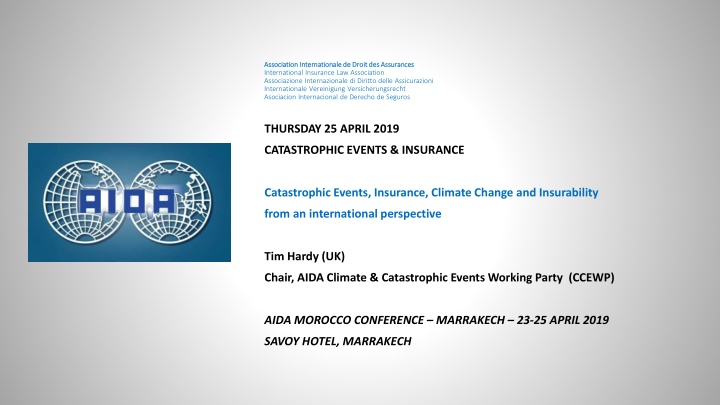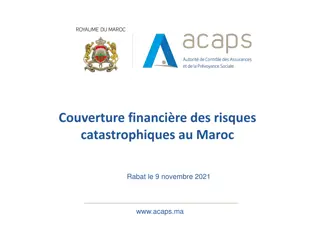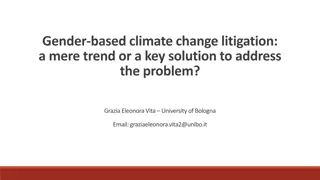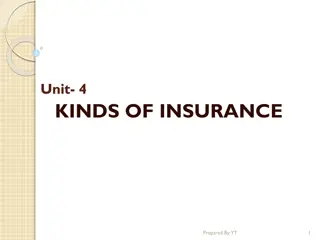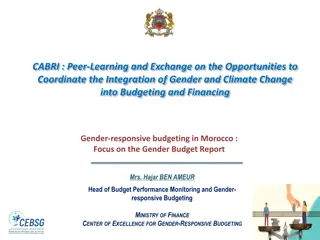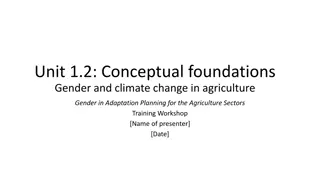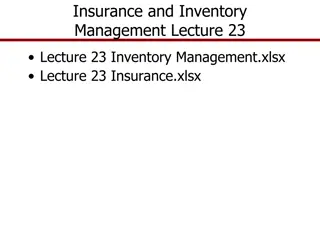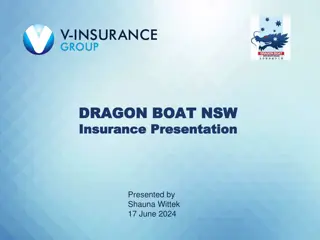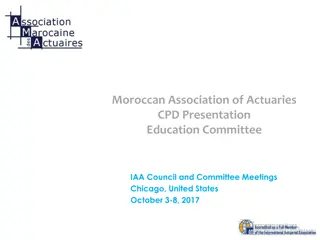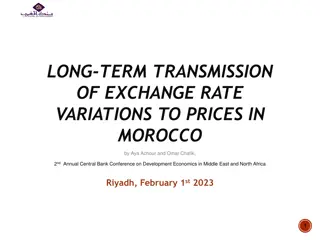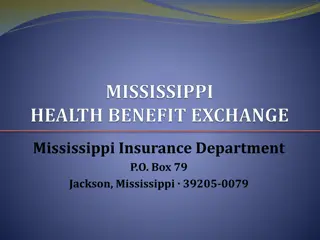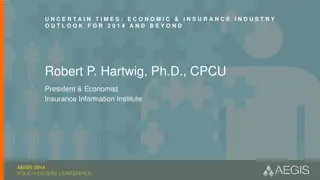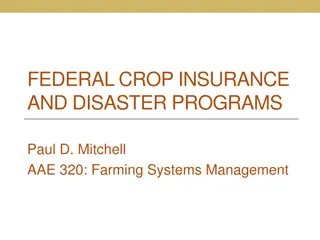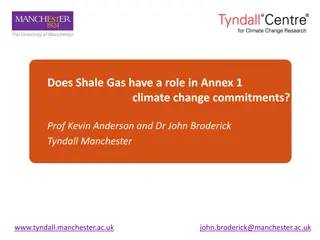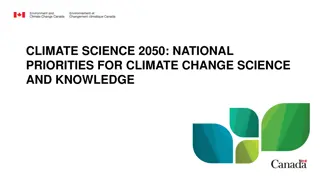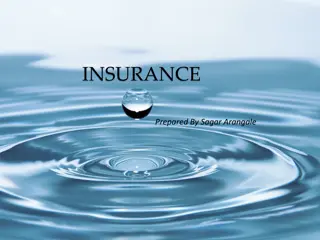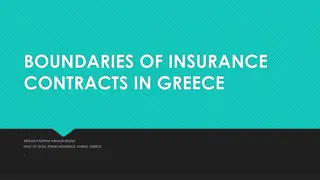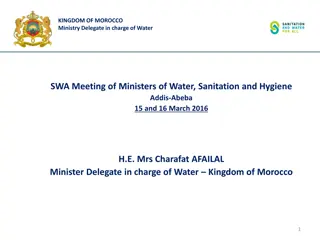Catastrophic Events, Insurance, and Climate Change in Morocco: A Global Perspective
Exploring the challenges and opportunities surrounding catastrophic events, insurance, and climate change in Morocco from an international viewpoint. The discussion covers the merits of pooling knowledge, strengths and weaknesses of compulsory insurance schemes, disparities in risk, hybrid disasters, parametric insurance, and the quest to bridge the protection gap amidst evolving disaster risk management strategies and climate change impacts.
Download Presentation

Please find below an Image/Link to download the presentation.
The content on the website is provided AS IS for your information and personal use only. It may not be sold, licensed, or shared on other websites without obtaining consent from the author.If you encounter any issues during the download, it is possible that the publisher has removed the file from their server.
You are allowed to download the files provided on this website for personal or commercial use, subject to the condition that they are used lawfully. All files are the property of their respective owners.
The content on the website is provided AS IS for your information and personal use only. It may not be sold, licensed, or shared on other websites without obtaining consent from the author.
E N D
Presentation Transcript
Association Association Internationale Internationalede Droit des Assurances International Insurance Law Association Associazione Internazionale di Diritto delle Assicurazioni Internationale Vereinigung Versicherungsrecht Asociacion Internacional de Derecho de Seguros de Droit des Assurances THURSDAY 25 APRIL 2019 CATASTROPHIC EVENTS & INSURANCE Catastrophic Events, Insurance, Climate Change and Insurability from an international perspective Tim Hardy (UK) Chair, AIDA Climate & Catastrophic Events Working Party (CCEWP) AIDA MOROCCO CONFERENCE MARRAKECH 23-25 APRIL 2019 SAVOY HOTEL, MARRAKECH
Catastrophic Events, Insurance, Climate Change and Insurability Catastrophic Events, Insurance, Climate Change and Insurability from an international perspective from an international perspective Outline 1. Introduction / Merits of pooling know-how and knowledge 2. Morocco now and in future? 3. Strengths/weaknesses of compulsory insurance schemes 4. Perils of regional/social disparity of risk 5. Hybrid natural v man-made disasters 6. Parametric insurance and agricultural risk 7. Reducing or maintaining the Protection Gap?
Catastrophic Events, Insurance, Climate Change and Insurability Catastrophic Events, Insurance, Climate Change and Insurability from an international perspective from an international perspective 1. Introduction/Merits of pooling know-how and knowledge Increased risk/scale of natural disasters - combination of socio-economic development + climate change a worldwide phenomenon No two countries - nor regions within countries - share same challenges Most have experience, know-how or data to share/inform best practice in policy- making and operational delivery but how/well will they? Morocco: a fascinating set of challenges + initiatives Climate change: largest risk management challenge of all time Transition from disaster response to evolving disaster risk management/prevention. Harness benefits of insurance. Identify/fix operational weaknesses undermining efficacy of best-laid/intentioned plans.
Catastrophic Events, Insurance, Climate Change and Insurability Catastrophic Events, Insurance, Climate Change and Insurability from an international perspective from an international perspective 2. Morocco now - a third of population/GDP at high risk (per GFDRR Report) Most significant risks (per OECD Report, 2016) Flooding Drought Earthquakes Tsunami Other risks - including incidents/accidents arising from infrastructure elements/industrial installations which can lead to large disasters Notable features Fast-developing economy Rapid increase in urbanisation/coastalisation/concentration of increased economic values at risk Recent history of major losses/developed and growing insurance market - but still relatively low insurance penetration levels Many businesses, never mind homeowners, do not even cover traditional risks of fire or business interruption.
Catastrophic Events, Insurance, Climate Change and Insurability Catastrophic Events, Insurance, Climate Change and Insurability from an international perspective from an international perspective 2. Morocco in future - Improved disaster risk financing and insurance - part of wider integrated disaster and climate risk management programme Mixed system: Insurance: Obligatory insurance against consequences of catastrophic events in: Property insurance contracts Motor liability Corporate liability - with regulated per-event, per-year indemnity limits + contractual limits/deductibles Compensation: Personal injury (to max. of 70% estimated loss) Allowance for loss of principal residence (equivalent 70% values/other limits apply) Solidarity Fund for additional payments What lessons/most notable challenges to be learnt for Morocco from others past experience or for others from this? Some examples
Catastrophic Events, Insurance, Climate Change and Insurability Catastrophic Events, Insurance, Climate Change and Insurability from an international perspective from an international perspective 3. Strengths/weaknesses of any compulsory insurance scheme EU Green Paper in 2013: European member states invited to review/re-consider plans to facilitate/support/compel: increased coverage of appropriate disaster risk insurance financial risk transfer markets regional insurance pooling options. No two countries/perils merit uniform treatment. Most favoured: disparate country models to continue - private insurers to remain primary managers of risk transfer options - concentration on risk management education - full market flexibility. Obvious advantages of compulsion: acceleration of insurance penetration (provided mechanism for sale/operation/enforcement) + constrains adverse selection Disadvantages: moral hazard, reducing incentive for risk management development; higher premium unrelated to actual risk, seen as tax , leaving penetration levels low (e.g. Turkish Catastrophe Insurance Pool); potential inflexibility of contractual terms. OECD Report observes: (in Morocco) long-term benefits will occur when they encourage behavioural changes, while avoiding the moral hazards that can be caused by providing too much assistance.
Catastrophic Events, Insurance, Climate Change and Insurability Catastrophic Events, Insurance, Climate Change and Insurability from an international perspective from an international perspective 4. Perils of regional/social disparity of risk (and potentially worsening?) Obvious merit of introducing a semi-obligatory insurance model (such as proposed one in Morocco applying already in France/Belgium) to all property owners already voluntarily taking out insurance cf. obliging all property owners to do so. Depending on initial period results, can retain/extend/adapt. More contentious can be question of rating: should additional premiums be flat-rated (as in France) or reflective of location/risk (as advocated by some in other EU countries). How should any cross- subsidy best/most legitimately apply in accordance with existing law and longer-term objectives? Contra arguments: bundling can obscure real risk/cost. Where areas of high risk from e.g. earthquake, landslide, flooding is market competition/transparency compromised? In all countries: difficulties in reconciling national budgetary needs + individual exposures of disparate parties in regions facing particular challenges/unaffordability and/or unwillingness to pay Policies of regional and national authorities must also address planning/building codes + investment in resilience issues (also, climate change mitigation/adaptation) - if schemes to be politically and commercially feasible at national level. Investment in/usage of tools/technology that (re)insurance market can also provide, e.g. seismic data, flood mapping etc Recurring political/economic challenge in every country of treating insureds and those without insurance equitably in the eyes of all both before and in the aftermath of a major event
Catastrophic Events, Insurance, Climate Change and Insurability Catastrophic Events, Insurance, Climate Change and Insurability from an international perspective from an international perspective 5. Hybrid Natural and Man-made Disasters Proposals in Morocco and provisions/discussions in other countries have distinguished natural disasters from man-madeones, but distinction not always so clear-cut. A disaster may be declared /certified by appropriate authority, but challenges where cause/consequence confused. Of particular relevance - instances of flooding, landslides or wildfires role of human intervention, not entirely natural (cf. also failure to tackle climate change) Munich Re* have cited at least three instances by way of illustration where disasters wrongly deemed natural ones: Vajont Dam landslide, Italy (1963); TeseroDam breach, Tesero, Italy (1985); and Indonesia forest fires (2015). Significant role of dam construction/operation in Morocco s water-related measures/risk prevention + questions about long-term viability of dams in face of growing impact of climate change of particular note. Cases of devastation involving dams in Brazil (Minas Gerais, 2016 and 2019) and Australia (Brisbane floods, 2011) have been considered extensively by the AIDA CCEWP over recent years. Contentious policy issues and class actions and cross-actions involving the role of authorities in trying to prevent natural disasters => bound to become a feature in more jurisdictions over time with potential liability challenges. * source: Wolfgang Kron, Head of Research, 19.7.2016
Catastrophic Events, Insurance, Climate Change and Insurability Catastrophic Events, Insurance, Climate Change and Insurability from an international perspective from an international perspective 6. Parametric Insurance & Agriculture Risks Concerns about viability/affordability of traditional insurance products for many whose livelihoods depend on agriculture => more streamlined approaches being adopted in many countries including Morocco. Beyond government subsidies for agriculture risks, a range of parametric insurance solutions are being introduced for many of the most vulnerable/poorest. Rapid post-event payments are triggered by data readings for drought, rainfall, storms etc without need for costly/lengthy indemnity/causation issues needing to be pursued to expedite recovery Essential, however, as seen in other jurisdictions, that national regulatory and legal frameworks evolve to permit such methods to be supervised and operated soundly, beyond existing parameters and without damaging existing insurance business.
Catastrophic Events, Insurance, Climate Change and Insurability Catastrophic Events, Insurance, Climate Change and Insurability from an international perspective from an international perspective 7. Different Types of Protection Gap Entity Much is written about the Protection Gap * in terms of the gap between losses occasioned by major disasters and those covered by insurance (about 70% globally). Many examples of Protection Gap Entities (PGEs) have been established around the world. Usually in response to specific/local needs. Often arising from major natural perils. PGE objectives usually: a) resolve disruption in reinsurance supply in mature markets; b) mitigate threat of unaffordable insurance in mature markets; or c) increase the financial viability of sovereign states with fragile economies. Important to realise that PGEs take different forms: as an insurer (like the New ZealandEQC); as a reinsurer (Caisse Centrale de Reassurances (CCR) of France, of more later or Flood Re (UK); or as market capturer/provider like Consorcio de Compensacion de Seguros(CCS) of Spain. Each has different merits/risks. * See especially Cass Business School Report, Prof. Jarzabkowski, 26.6.18
Catastrophic Events, Insurance, Climate Change and Insurability Catastrophic Events, Insurance, Climate Change and Insurability from an international perspective from an international perspective 7. each at risk of distorting market operation over time or even perpetuating gaps in coverage Often created to fulfil urgent stop-gap need. In the case of Flood Re, from a protracted uneasy truce between the UK private market and government. Operated by the industry, but backed by legislation. The government levies policyholders to fund the pool and also finances flood defences. Balance to be struck to ensure they evolve to meet changing conditions (especially in age of climate change impact altering original remit) without expanding operations simply to justify continued existence. Can also unnaturally/unrealistically raise expectations of those involved. Important always for governments of every nation continually to assess gaps in own planning/funding for disaster relief and to identify where international collaboration or support required. In case of Morocco, OECD Report identified need to address, inter alia, disaster scenarios of lower probability/higher potential damage; two major floods at same time; regulation of industrial installations to prevent accident; early warning systems; and noting worthy build back better principles cannot of course be followed without funds (being made) available to achieve this. A salutary, rather than pessimistic, warning, that one of course can never fully prepare for disaster
Association Association Internationale Internationale de Droit des Assurances International Insurance Law Association Associazione Internazionale di Diritto delle Assicurazioni Internationale Vereinigung Versicherungsrecht Asociacion Internacional de Derecho de Seguros de Droit des Assurances THURSDAY 25 APRIL 2019 CATASTROPHIC EVENTS & INSURANCE Catastrophic Events, Insurance, Climate Change and Insurability from an international perspective Tim Hardy (UK) Chair, AIDA Climate & Catastrophic Events Working Party (CCEWP) AIDA MOROCCO CONFERENCE MARRAKECH 23-25 APRIL 2019 SAVOY HOTEL, MARRAKECH
